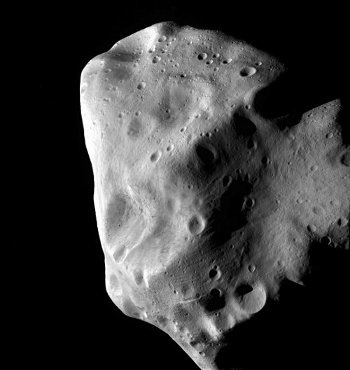This morning we stick with the planetary migration theme begun on Friday, when the subject was a possible ice giant that was expelled from the Solar System some 600 million years after formation. We have a lot to learn about the mechanisms that could force such ejections, but it’s becoming clear that objects up to planet size do indeed migrate, as witness the latest findings on the asteroid Lutetia. Using spectral information put together from space- and ground-based telescopes including ESA’s Rosetta spacecraft, scientists have determined that Lutetia is a fragment of the same inner system material that went into the inner rocky planets. A gravitational encounter somewhere in the inner system would then have propelled it outward to the Main Belt.

The observations pulled together data in visible, ultraviolet, near-infrared and mid-infrared wavelengths. The only kind of meteorite that matches the spectrum of Lutetia exactly is the type known as enstatite chondrites, known to be material from the early Solar System, and thought to have been a major constituent in the formation of the Earth, Venus and Mercury. Isotope measurements of enstatite chondrites show that they are the only groups of chondrites that have an isotopic composition that is the same as that of the Earth and Moon, and their chemistry and mineralogy supports the idea that they formed close to the Sun. Mercury seems to have accreted from these materials.
Image: New observations indicate that the asteroid Lutetia is a leftover fragment of the same original material that formed the Earth, Venus and Mercury. Credit: ESA/Rosetta.
If Lutetia formed in the inner system, it would be a part of the less than 2 percent of bodies located in the region where the Earth formed that wound up in the asteroid belt. So in this case we have not a planetary ejection, but an asteroid migration, the movement of an object about 100 kilometers across that was propelled outward through an encounter with one of the inner planets. The migration scenario could involve more than just the rocky planets of the inner system, as the paper on this work notes:
The question naturally arises as to how Lutetia escaped accretion into one of the terrestrial planets and ultimately reached the main belt. The dynamical mechanism is likely to be similar to the one explaining the origin of iron meteorites as remnants of differentiated planetesimals formed in the terrestrial planet region… Extended dynamical simulations reveal that, at the time when terrestrial accretion was ongoing, a small fraction (<2%) of the planetesimals residing in the 0.5-1.5 AU region were scattered out by emerging protoplanets… and/or by the migration of Jupiter… and achieved main-belt orbits, thus becoming dynamically indistinguishable from the rest of the main-belt population.
But Lutetia would be carrying evidence for a far different interior than most asteroids:
According to this scenario, planetesimals of the size of Lutetia (D ~ 100 km) that formed in the 0.5-1.5 AU region experienced significantly more heating by short-lived nuclides than asteroids formed in the main belt. A direct consequence is that most of these planetesimals are likely to be differentiated in accordance with iron meteorites having formed in this region.
All of this adds to the buzz about an asteroid that, in terms of color and surface properties, was already considered unusual. It wasn’t long ago that we discussed Lutetia’s once having had a hot metallic core, based on evidence from the Rosetta encounter in July of 2010. The suggestion was that although it had a battered, unmelted surface, Lutetia may have had a differentiated interior, making it a primordial planetesimal. That would make it a highly interesting relic of the period of planetary formation, and the new work adds to the case for more intense study of the asteroid, as ESO’s Pierre Vernazza, lead author of the paper on the new work, comments:
“Lutetia seems to be the largest, and one of the very few, remnants of such material in the main asteroid belt. For this reason, asteroids like Lutetia represent ideal targets for future sample return missions. We could then study in detail the origin of the rocky planets, including our Earth.”
The paper is Vernazza et al., “Asteroid (21) Lutetia as a remnant of Earth’s precursor planetesimals,” accepted for publication in Icarus (preprint).



Might this even be a piece of shrapnel from the collision that produced our moon?
One notes that ‘migration’ goes on today.
Earth crossing NEOs , have of course, been known for a long time… but a paper by Jack Wisdom , of MIT, in 1982, showed that asteroids in the belt between Mars and Jupiter could evolve by way of resonances into Earth crosses. We have a population of NEOs from there and will have some new ones as time goes on.
Jack Wisdom (1982). “The origin of the Kirkwood gaps – A mapping for asteroidal motion near the 3/1 commensurability”. Astronomical Journal 87: 577–593
An amusing note. There are also four Apollo era SIV-Bs and one Lunar Module ascent stage in ‘Earth’ orbit. They come back and visit us at time.
One or more may impact the Earth or Moon someday, but no one is sure when.
Alas, almost all the tracked data on them had to be disposed of for storage reasons.